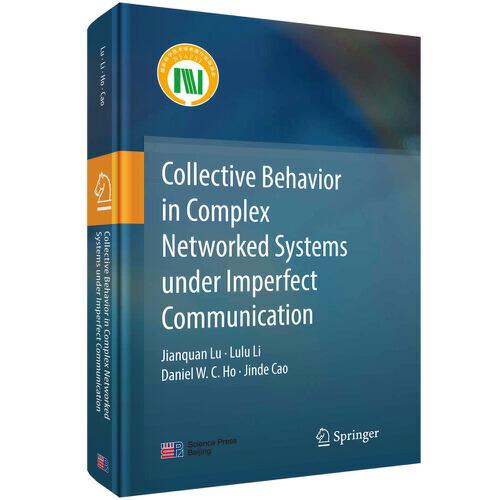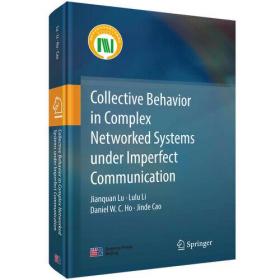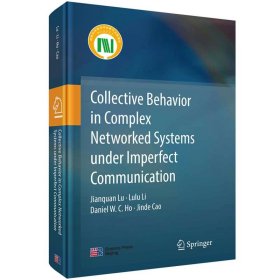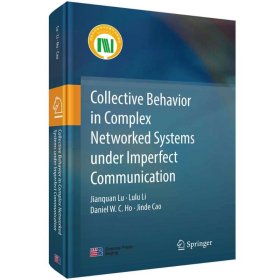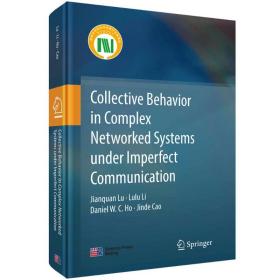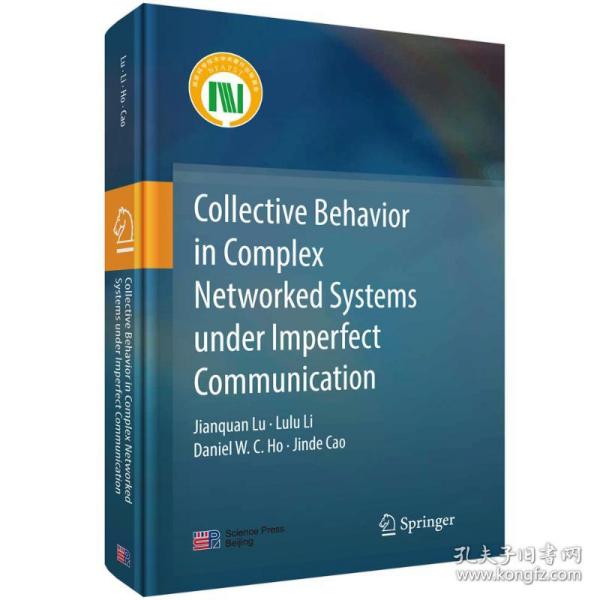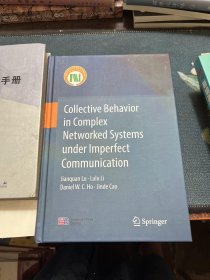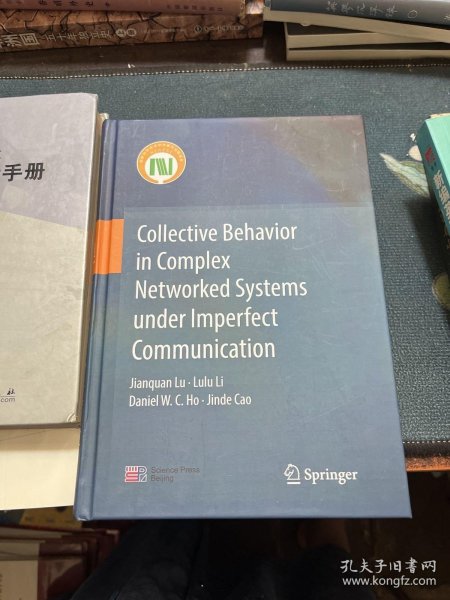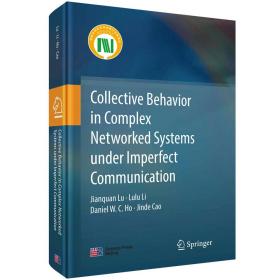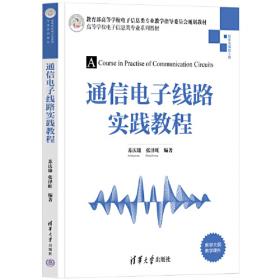通信约束下复杂网络化系统的群体行为(英文版)
出版时间:
2021-08
版次:
1
ISBN:
9787030693846
定价:
159.00
装帧:
精装
开本:
16开
纸张:
胶版纸
页数:
260页
字数:
330.000千字
-
Thisbookaimstoexplainhowcollectivebehaviorisformedvialocalinteractionsunderimperfectcommunicationincomplexnetworkedsystems.Italsopresentssomenewdistributedprotocolsoralgorithmsforcomplexnetworkedsystemstocomplywithbandwidthlimitationandtoleratecommunicationdelays.《BR》 Thisbookwillbeofparticularinteresttothereadersduetothebenefits:1)itstudiestheeffectoftimedelayandquantizationonthecollectivebehaviorbynon-smoothanalyticaltechniqueandalgebraicgraphtheory;2)itintroducestheevent-basedconsensusmethodunderdelayedinformationtransmission;Inthemeantime,itpresentssomenovelapproachestohandlethecommunicationconstraintsinnetworkedsystems;3)itgivessomesynchronizationandcontrolstrategiesforcomplexnetworkedsystemswithlimitedcommunicationabilities.Furthermore,itprovidesaconsensusrecoveryapproachformulti-agentsystemswithnodefailure.Also,itpresentsinterestingresultsaboutbipartiteconsensusandfixed-time/finite-timebipartiteconsensusofnetworkswithcooperativeandantagonisticinteractions. Contents
Preface
List of Symbols
Chapter 1 Introduction 1
1.1 Background 1
1.2 Research problems 3
1.2.1 Consensus and practical consensus 6
1.2.2 General model description 6
1.3 Mathematical preliminaries 8
1.3.1 Matrices and graphs 8
1.3.2 Signed graphs 9
1.3.3 Quantizer 11
1.3.4 Discontinuous differential equations 12
1.3.5 Some lemmas 13
References 14
Chapter 2 Consensus over Directed Static Networks with Arbitrary Finite Communication Delays 20
2.1 Linear coupling 21
2.1.1 The case of leaderless 21
2.1.2 The case with one well-informed leader 23
2.2 Nonlinear coupling 25
2.3 Hierarchical structure 27
2.4 Numerical examples 28
2.5 Summary 32
References 32
Chapter 3 Practical Consensus of Multi-Agent Networks with Communication Constraints 35
3.1 Practical consensus with quantized data 36
3.1.1 Model description 36
3.1.2 Finite-time practical consensus under quantization 37
3.1.3 Numerical example 41
3.2 Consensus with hybrid communication constraints 42
3.2.1 Model description and preliminaries 42
3.2.2 The existence of the Filippov solution 43
3.2.3 Practical consensus under quantization and time delay 46
3.2.4 Numerical example 59
3.2.5 Discussions 61
3.3 Summary 64
References 65
Chapter 4 Multi-Agent Consensus with Quantization and Communication Delays 67
4.1 Discrete-time case 67
4.1.1 Model description 68
4.1.2 Main results 68
4.1.3 Numerical example 73
4.2 Continuous-time case 74
4.2.1 Model description and preliminaries 74
4.2.2 The existence of the Filippov solution 75
4.2.3 Consensus analysis under quantization and time delays 77
4.2.4 Numerical example 86
4.3 Summary 87
References 87
Chapter 5 Event-Based Network Consensus with Communication Delays 89
5.1 Distributed discrete-time event-triggered consensus with delays 89
5.1.1 Model description 90
5.1.2 Distributed event-triggered approach 91
5.1.3 Numerical example 97
5.2 Distributed continuous-time event-triggered consensus with delays 99
5.2.1 Model description 99
5.2.2 Asynchronously distributed event-triggered approach 100
5.2.3 Synchronously event-triggered control 107
5.2.4 Numerical example 110
5.3 Summary 111
References 112
Chapter 6 Consensus of Networked Multi-Agent Systems with Antagonistic Interactions and Communication Delays 114
6.1 Continuous-time multi-agent consensus 115
6.1.1 Linear coupling 115
6.1.2 Nonlinear coupling 121
6.1.3 Numerical examples 124
6.2 Discrete-time multi-agent consensus 127
6.2.1 Distributed event-based bipartite consensus 127
6.2.2 Self-triggered approach 140
6.2.3 Numerical example 143
6.3 Summary 146
References 146
Chapter 7 Finite-Time and Fixed-Time Bipartite Consensus for Multi-Agent Systems with Antagonistic Interactions 148
7.1 Preliminaries 150
7.2 Finite-time bipartite consensus 151
7.2.1 Finite-time bipartite consensus protocol 151
7.2.2 Pinning bipartite consensus protocol 156
7.2.3 Numerical examples 159
7.3 Fixed-time bipartite consensus 163
7.3.1 General fixed-time bipartite consensus 165
7.3.2 Signed-average fixed-time bipartite consensus 168
7.3.3 Numerical examples 171
7.4 Summary 173
References 174
Chapter 8 Globally Exponential Synchronization and Synchronizability for General Dynamical Networks 178
8.1 Preliminaries 179
8.2 Synchronization analysis 181
8.2.1 Irreducible case 181
8.2.2 Reducible case 189
8.3 Numerical examples 193
8.4 Summary 200
References 200
Chapter 9 Pinning Cluster Synchronization in an Arrayof Coupled Neural Networks under Event-Based Mechanism 203
9.1 Preliminaries and problem formulation 204
9.2 Pinning cluster synchronization under event-triggered mechanism 207
9.3 Pinning cluster synchronization under self-triggered mechanism 214
9.4 Numerical example 217
9.5 Summary 222
References 222
Chapter 10 Multi-Agent Consensus Recovery Approach under Node Failure 225
10.1 Preliminaries 225
10.2 Consensus analysis of general multi-agent networks 227
10.3 Consensus recovery approach 232
10.4 Numerical examples 239
10.5 Summary 244
References 244
Chapter 11 Conclusion and FutureWork 246
11.1 Conclusion 246
11.2 Future work 247
Color Illustrations
-
内容简介:
Thisbookaimstoexplainhowcollectivebehaviorisformedvialocalinteractionsunderimperfectcommunicationincomplexnetworkedsystems.Italsopresentssomenewdistributedprotocolsoralgorithmsforcomplexnetworkedsystemstocomplywithbandwidthlimitationandtoleratecommunicationdelays.《BR》 Thisbookwillbeofparticularinteresttothereadersduetothebenefits:1)itstudiestheeffectoftimedelayandquantizationonthecollectivebehaviorbynon-smoothanalyticaltechniqueandalgebraicgraphtheory;2)itintroducestheevent-basedconsensusmethodunderdelayedinformationtransmission;Inthemeantime,itpresentssomenovelapproachestohandlethecommunicationconstraintsinnetworkedsystems;3)itgivessomesynchronizationandcontrolstrategiesforcomplexnetworkedsystemswithlimitedcommunicationabilities.Furthermore,itprovidesaconsensusrecoveryapproachformulti-agentsystemswithnodefailure.Also,itpresentsinterestingresultsaboutbipartiteconsensusandfixed-time/finite-timebipartiteconsensusofnetworkswithcooperativeandantagonisticinteractions.
-
目录:
Contents
Preface
List of Symbols
Chapter 1 Introduction 1
1.1 Background 1
1.2 Research problems 3
1.2.1 Consensus and practical consensus 6
1.2.2 General model description 6
1.3 Mathematical preliminaries 8
1.3.1 Matrices and graphs 8
1.3.2 Signed graphs 9
1.3.3 Quantizer 11
1.3.4 Discontinuous differential equations 12
1.3.5 Some lemmas 13
References 14
Chapter 2 Consensus over Directed Static Networks with Arbitrary Finite Communication Delays 20
2.1 Linear coupling 21
2.1.1 The case of leaderless 21
2.1.2 The case with one well-informed leader 23
2.2 Nonlinear coupling 25
2.3 Hierarchical structure 27
2.4 Numerical examples 28
2.5 Summary 32
References 32
Chapter 3 Practical Consensus of Multi-Agent Networks with Communication Constraints 35
3.1 Practical consensus with quantized data 36
3.1.1 Model description 36
3.1.2 Finite-time practical consensus under quantization 37
3.1.3 Numerical example 41
3.2 Consensus with hybrid communication constraints 42
3.2.1 Model description and preliminaries 42
3.2.2 The existence of the Filippov solution 43
3.2.3 Practical consensus under quantization and time delay 46
3.2.4 Numerical example 59
3.2.5 Discussions 61
3.3 Summary 64
References 65
Chapter 4 Multi-Agent Consensus with Quantization and Communication Delays 67
4.1 Discrete-time case 67
4.1.1 Model description 68
4.1.2 Main results 68
4.1.3 Numerical example 73
4.2 Continuous-time case 74
4.2.1 Model description and preliminaries 74
4.2.2 The existence of the Filippov solution 75
4.2.3 Consensus analysis under quantization and time delays 77
4.2.4 Numerical example 86
4.3 Summary 87
References 87
Chapter 5 Event-Based Network Consensus with Communication Delays 89
5.1 Distributed discrete-time event-triggered consensus with delays 89
5.1.1 Model description 90
5.1.2 Distributed event-triggered approach 91
5.1.3 Numerical example 97
5.2 Distributed continuous-time event-triggered consensus with delays 99
5.2.1 Model description 99
5.2.2 Asynchronously distributed event-triggered approach 100
5.2.3 Synchronously event-triggered control 107
5.2.4 Numerical example 110
5.3 Summary 111
References 112
Chapter 6 Consensus of Networked Multi-Agent Systems with Antagonistic Interactions and Communication Delays 114
6.1 Continuous-time multi-agent consensus 115
6.1.1 Linear coupling 115
6.1.2 Nonlinear coupling 121
6.1.3 Numerical examples 124
6.2 Discrete-time multi-agent consensus 127
6.2.1 Distributed event-based bipartite consensus 127
6.2.2 Self-triggered approach 140
6.2.3 Numerical example 143
6.3 Summary 146
References 146
Chapter 7 Finite-Time and Fixed-Time Bipartite Consensus for Multi-Agent Systems with Antagonistic Interactions 148
7.1 Preliminaries 150
7.2 Finite-time bipartite consensus 151
7.2.1 Finite-time bipartite consensus protocol 151
7.2.2 Pinning bipartite consensus protocol 156
7.2.3 Numerical examples 159
7.3 Fixed-time bipartite consensus 163
7.3.1 General fixed-time bipartite consensus 165
7.3.2 Signed-average fixed-time bipartite consensus 168
7.3.3 Numerical examples 171
7.4 Summary 173
References 174
Chapter 8 Globally Exponential Synchronization and Synchronizability for General Dynamical Networks 178
8.1 Preliminaries 179
8.2 Synchronization analysis 181
8.2.1 Irreducible case 181
8.2.2 Reducible case 189
8.3 Numerical examples 193
8.4 Summary 200
References 200
Chapter 9 Pinning Cluster Synchronization in an Arrayof Coupled Neural Networks under Event-Based Mechanism 203
9.1 Preliminaries and problem formulation 204
9.2 Pinning cluster synchronization under event-triggered mechanism 207
9.3 Pinning cluster synchronization under self-triggered mechanism 214
9.4 Numerical example 217
9.5 Summary 222
References 222
Chapter 10 Multi-Agent Consensus Recovery Approach under Node Failure 225
10.1 Preliminaries 225
10.2 Consensus analysis of general multi-agent networks 227
10.3 Consensus recovery approach 232
10.4 Numerical examples 239
10.5 Summary 244
References 244
Chapter 11 Conclusion and FutureWork 246
11.1 Conclusion 246
11.2 Future work 247
Color Illustrations
查看详情
-
全新
山东省济宁市
平均发货68小时
成功完成率80.76%
-
全新
江苏省无锡市
平均发货18小时
成功完成率87.14%
-
全新
湖北省武汉市
平均发货15小时
成功完成率94.52%
-
九五品
北京市东城区
平均发货34小时
成功完成率82.72%
-
全新
江苏省南京市
平均发货16小时
成功完成率82.72%
-
全新
江苏省南京市
平均发货20小时
成功完成率47.93%
-
全新
北京市东城区
平均发货30小时
成功完成率83.98%
-
全新
山东省潍坊市
平均发货10小时
成功完成率85.18%
-
全新
江苏省无锡市
平均发货18小时
成功完成率94.42%
-
全新
海南省海口市
平均发货14小时
成功完成率82.41%
-
全新
江苏省无锡市
平均发货8小时
成功完成率95.84%
-
全新
江苏省无锡市
平均发货18小时
成功完成率92.26%
-
全新
江苏省南京市
平均发货16小时
成功完成率82.72%
-
全新
广东省广州市
平均发货20小时
成功完成率86.48%
-
全新
江苏省南京市
平均发货8小时
成功完成率96.7%
-
全新
江苏省南京市
平均发货7小时
成功完成率97.77%
-
全新
北京市西城区
平均发货30小时
成功完成率90.45%
-
全新
广东省广州市
平均发货8小时
成功完成率89.09%
-
全新
天津市河东区
平均发货29小时
成功完成率89.92%
-
全新
北京市朝阳区
平均发货9小时
成功完成率96.78%
-
全新
北京市顺义区
平均发货14小时
成功完成率94.37%
-
全新
北京市顺义区
平均发货22小时
成功完成率94.24%
-
全新
河北省保定市
平均发货15小时
成功完成率91.06%
-
九五品
北京市朝阳区
平均发货16小时
成功完成率93.9%
-
全新
广东省广州市
平均发货21小时
成功完成率80.14%
-
全新
广东省广州市
平均发货18小时
成功完成率87.77%
-
全新
北京市通州区
平均发货52小时
成功完成率71.32%
-
全新
广东省广州市
平均发货7小时
成功完成率90.41%
-
全新
天津市西青区
平均发货20小时
成功完成率84.44%
-
全新
江苏省无锡市
平均发货7小时
成功完成率89.17%
-
全新
北京市通州区
平均发货39小时
成功完成率51.35%
-
全新
北京市朝阳区
平均发货46小时
成功完成率78.57%
-
全新
北京市通州区
平均发货47小时
成功完成率68.89%
-
全新
北京市通州区
平均发货59小时
成功完成率80.3%
-
全新
北京市朝阳区
平均发货38小时
成功完成率81.82%
-
全新
-
全新
-
九五品
北京市朝阳区
平均发货26小时
成功完成率82.89%
-
全新
江西省吉安市
平均发货4天内
成功完成率84.19%
-
全新
北京市通州区
平均发货4天内
成功完成率70.59%

 占位居中
占位居中

